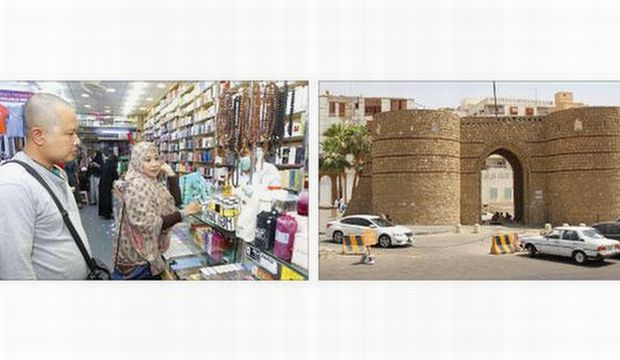Jeddah, Asharq Al-Awsat—Walking around the narrow alleyways, souqs (traditional markets) and hundred-year-old buildings of Downtown Jeddah, or Al-Balad, in Saudi Arabia, at this time of year, is like being in the middle of an international convention of languages and cultures. For residents of the Red Sea coastal city, the millions of visitors from over 130 different countries crammed into a five kilometer area are a familiar sight at the end of every Hijri calendar. For the pilgrims, it is the last stop before leaving Saudi Arabia and a hotspot for buying souvenirs.
Moving through the crowds from Qabel Street’s souq—an 80-year-old large traditional market for buying clothes and exchanging currency—into the heart of the historical city, towards Nasseef House and east towards the archaeological district, you are caught in a trail of flashing cameras and mobile phones.
Zadi Mohamed, visiting from India, told Asharq Al-Awsat: “[this district] reminds me of some of the old historical Indian markets, especially its small shops, narrow alleys and diversity of goods. The prices here are far more reasonable than in the large malls.”
From Qabel Street, many tourists turn right into the large Souq Al-Nada—located within the walls of the old city and established nearly 150 years ago—famous for selling traditional Saudi garments like headdresses and jilabas.
A visit to the Souq Al-Nada is considered a trip in itself. After a day of shopping, visitors will often unwittingly find themselves in the middle of its large traditional food court having been drawn in by its delicious wafting aromas. Here, chefs busily prepare the traditional meat and fish dishes called Mandi and Sayadia. Popular among Asians and Africans alike, Mandi is made by cooking cow and goat heads in an underground kiln before the meat and brains are removed and served with salad, rice and bread.
According to unofficial statistics, nearly three thousand Saudi and international visitors flock to the souq every day. Jad Bilal, visiting from Senegal with a group of friends, said: “I’m here to buy clothes for my wife and my children. I can’t deny that the delicious smell from the market prompted me to eat here too.”
After finishing their meal, a visitor can choose to either go directly to the historical sites or wander between the souqs of Al-Alawi, Al-Khaskiya and Al-Badu (tribes)—the latter being the first stop for visitors from the east of the old city. Souq Al-Badu has been frequented by villagers and nomads from across Mecca for over 140 years who come to buy clothes and other apparel, including female face covers, as well as saffron and cinnamon, basic commodities such as rice and wheat, and copper wares.
The souq is as popular with Europeans as it is with those from Arab countries for purchasing gifts, antiques, traditional wares or Eastern spices.
Omm Mohamed, from Tunisia, told Asharq Al-Awsat: “What distinguishes this market is the variety of produce; from clothing to basic food commodities. Every time I, or any of my family members, come here, we buy large amounts of spices which I use in cooking.”
Entering Nasseef square, you are immediately faced with its old buildings and traditional food displays located in a three-meter-wide lane which ends at the entrance of Mecca Souq. Many visitors are busy taking photos or asking about one place or another. Saad Basaloum, a shop owner in the historical district, says that “we are accustomed to [these visitors]; once at the end of the pilgrimage season and once during the Umrah [minor pilgrimage] season when the Arab communities are more dominant.”
“The pilgrimage seasons bring us a lot of visitors of different nationalities. Seeing and dealing with those visitors has encouraged shop owners to learn foreign languages in order to be able to communicate the correct information,” he added.

